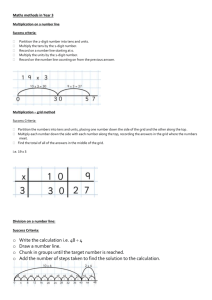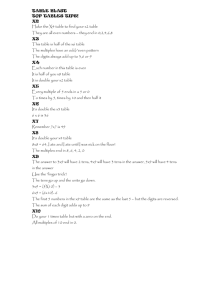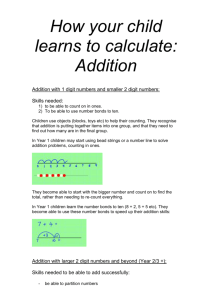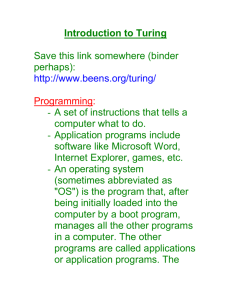Written Methods of Calculation in Numeracy at Key Stage 2: A guide
advertisement
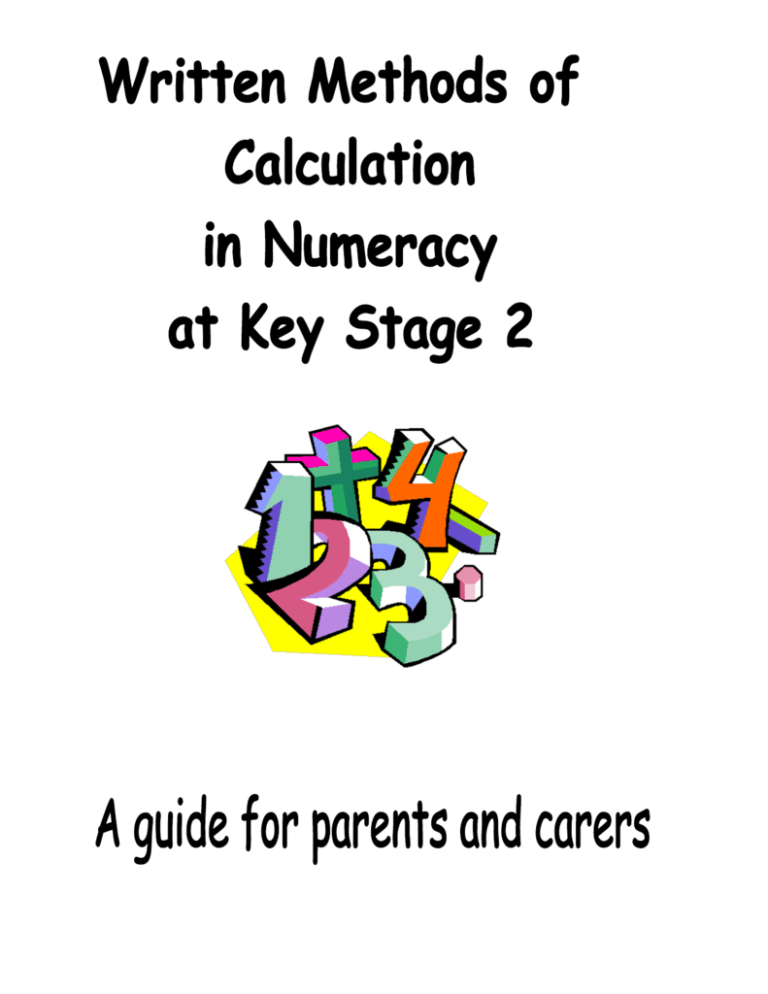
Many parents and carers ask us how they can help their child with maths. One of the best things you can do with your children is talk to them about maths. Sometimes it is even more important that you listen and let them explain what they are doing and why. This booklet is designed to help you to understand some of the methods of calculation that they may be working on in class. In Key Stage 1 children often draw pictures and diagrams to help them to understand their workings. A lot of emphasis is placed on asking the children to explain how they work things out; how they arrived at a particular answer. We acknowledge the childrens’ ability to use different approaches to the same sum, for example, when adding 18 and 9 some children will count on from 18 where as others may add on 10 then take away 1. In the Key Stage 2 years the children will do more work with written sums. If you don’t recognise these methods please don’t insist that your child carry out calculations in the way that you do them. There are often several different ways of calculating and each child will find the method that he/she feels most comfortable with and leads to a consistent level of accuracy. This booklet explains the expanded informal methods which show the children the reasoning behind the steps involved in calculations, before moving onto the more common compact, standard methods. 1 Children working on the Year 3 objectives will use informal pencil and paper methods (jottings) to support, record or explain their calculations. These methods build upon existing mental strategies. Most children will set sums out horizontally, like this 86 + 57 = and work them out using methods such as; a) 86 + 57 = 86 + 50 + 7 = 136 + 7 = 143 b) 86 + 57 = (80 + 50) + (6 +7) = 130 + 13 = 143 +50 +4 +3 c) _____________________________ 86 136 140 143 These are preparation for efficient, standard methods where calculations are set out in columns; units line up under units, tens under tens and so on. 46 + 27 60 (40 + 20, adding tens first) + 13 ( 6 + 7, then adding units) 73 or 46 + 27 13 + 60 73 2 (adding units first) ( then adding tens) 256 + 85 11 (units) + 130 (tens) 200 (hundreds) 341 Children working on the Year 4, 5 and 6 objectives will use pencil and paper methods to support, record or explain their calculations, achieving consistent accuracy. When setting sums out vertically the children will continue to line up tens under tens, units under units and so on. Examples of some of the methods are as follows; a) adding the most significant digits first, mentally, from the top, working on Yr 4 objectives 625 + 48 600 + 60 13 673 (adding hundreds) (adding tens) (adding units) Year 5 objectives 587 + 475 900 (adding hundreds) + 150 (adding tens) 12 (adding units) 1062 Year 6 objectives 7648 + 1486 8000 +1000 120 14 9134 (add thousands) (add hundreds) (add tens) (add units) b) compensation ( add too much, take off) Year 4 objectives 754 + 86 854 - 14 840 (754 + 100) (86 to 100 is 14) (86 is rounded up to 100) Year 5 objectives 654 + 286 954 (654 + 300) - 14 (286 to 300) 940 (286 is rounded up to 300) 3 Year 6 objectives N/A c) standard written methods, adding the least significant digits first, using “carrying” Year 4 objectives 358 + 73 11 (units) + 120 (tens) 300 (hundreds) 431 Year 5 objectives 358 + 73 ( leading to) 587 + 475 1062 431 1 11 Year 6 objectives 7648 + 1486 9134 111 6584 +5848 12 4 3 2 1 1 1 d) extend to decimals, using similar methods to those above, ensuring that the decimal points line up with each other. 4 Children working on the Year 3 objectives will use informal pencil and paper methods (jottings) to support, record or explain partial mental methods, building on existing strategies. Most children will set sums out horizontally, like this, such as; a) 84 – 56 and work them out using methods counting up from the smaller to the larger number (complimentary addition) 1) 84 - 56 +4 +20 +4 or _______________________________ 56 60 80 84 becomes 56 + 4 + 20 + 4 = 84 4 + 20 + 4 = 28 +4 +40 +300 +83 _________________________________________ 356 360 400 700 783 2) 783 – 356 b) compensation (take too much, add back) 1) 84 – 56 = 84 – 60 + 4 = 28 4 + 40 300 83 427 ( 56 is rounded up to 60 ) -60 ___+4________________________ 24 28 84 2) 783 – 356 = 783 – 400 + 44 = 383 + 44 = 427 c) decomposition, recording calculations in preparation for an efficient standard method 81 - 57 = 80 + 1 - 50 + 7 = 70 + 11 (adjust from T to U) - 50 + 7 20 + 4 = 24 5 Children working on the Year 4, 5 and 6 objectives will use pencil and paper methods to support, record or explain their calculations, achieving consistent accuracy. When setting sums out vertically they will continue to line up tens under tens, units under units and so on. Examples of some of the methods are as follows; a) counting up ( complimentary addition) working on the Year objectives 754 - 86 +4 +10 + 600 +50 +4 668 4 to 86 to make 90 to 90 to make 100 to make 700 to make 750 to make 754 Year 5 objectives 754 - 286 Year 6 objectives 6467 -2684 + 14 to 286 to make 300 +400 to make 700 + 54 to make 754 468 16 ( count up, 2684 to 2700) + 300 (count up, 2700 to 3000) 3467 (count up, 3000 to 6467) 3783 b) compensation, (take too much, add back) working on the Yr 754 - 86 654 + 14 668 4 objectives (round up to 100) (754 - 100) (86 to 100 = 14) Year 5 objectives 754 - 286 (round up to 300) 454 (754 - 300) + 14 (286 to 300 = 14) 468 Year 6 6467 - 2684 (round up to 3000) 3467 (6467 – 3000) + 316 (2684 to 3000) 3783 1 6 objectives c) standard written methods, decomposition working on the objectives for 754 = - 86 Year 4 and……. 700 + 50 + 4 - Year 5 leading to leading to (Yr 86 + 6 4 = 5) 1 700 + 40 + 1 4 (adjust from T to U) 7 5 4 80 + 6 - 8 6 d) extend to decimals, ensuring that the decimal points line up with each other. = 4 1 600+ 140 + 14 (adjust from H to T) 80 + 6 600+ 60 + 8 = 668 7 5 4 - 8 6 6 14 14 754 -86 668 d) extend to decimals, ensuring that the decimal points line up with each other. 7 and Year 6 . 5 3 1 6 4 6 7 - 2 6 8 4 3 7 8 3 Children working on the Year 3 objectives will use informal pencil and paper methods (jottings) to support, record or explain their calculations. These methods build upon existing mental strategies. Multiplication The children will need to know the 2, 5, and 10 times tables and have a working knowledge of the 3 and 4 times tables by the end of the academic year. They will be working on such problems as “If there are 10 gingerbread men in 1 packet, how many will there be in 3 packets?” Division The knowledge of the above multiplication tables is necessary for the objectives relating to division, along with a knowledge of doubles and halves. The children will be working on such problems as “How many lots of 3 go into 9?” and “What is 80 divided by 10?”. They will need to recognise the – sign and use the vocabulary related to division, such as “share”. 8 Children working on the Year 4, 5 and 6 objectives will use pencil and paper methods to support, record or explain their calculations, achieving consistent accuracy. They will discuss, explain and compare methods. Children working on the Year Mental method, partitioning. 4 objectives; Grid layout, expanded working. Standard written methods 38 x 7 = (30 x 7) + (8 x 7) Children working on the Year Grid layout, larger numbers 5 X 30 7 210 Short multiplication TU x U Eg 23 x 7. Estimate 20x10=200 8 23 leading to x 7 140 (20x7) 21 (3x7) 161 56 = 266 objectives Example: TU x TU 56 x 27 Estimate: 60 x 30 =,1800 56 x 27 = (50 + 6) x (20 + 7) Example: HTU x U 346 x 9 Estimate: 350 x 10 = 3500 346 x 9 = (300 + 40 + 6) x 9 X 20 7 X 300 9 2700 50 1000 350 6 120 = 42 = 1120 + 392 1512 40 360 6 54 = 3114 Standard written methods Short multiplication ; HTU x U Example: 346 x 9 Estimate 350 x 10 = 3500 346 x 9 2700 + 3 60 54 3 1 14 leading to (300 x 9) (40 x9) (6 x 9) Long multiplication: TU xTU Example: 72 x 38 Estimate: 70 x 40 = 2800 346 x 9 3 1 14 45 72 x 38 2160 (30x72) + 576 (8x72) 2736 1 9 Contd. 23 x7 161 2 Children working on the Year 5 objectives. (contd) Extend to simple decimals with one decimal place Multiply by a single digit, estimating first. Example 4.9 x 3 Estimate 5 x 3 = 15 4.0 x 3 = 12.0 0.9 x 3 = 2.7 14.7 Children working on the Year 6 objectives Informal written methods; grid method Example: Th H T U x U Example: 4346 x 8 Estimate: 4500 x 10 = 45000 Example: HTU x TU Example: 372 x 24 Estimate: 400 x 20 X 8 X 300 70 2 20 6000 1400 40 = 7440 4 1200 280 8 = + 1488 8928 4000 300 40 6 32000 2400 320 48 = 34768 Standard written methods Short multiplication: Th H T U x U Example: 4346 x 8 Estimate: 4500 x 10 = 45000 Long multiplication: HTU x TU Example: 352 x 27 Estimate: 350 x 30 = 10500 4346 X 8 32000 2400 + 320 48 34768 352 X 27 7040 + 2464 9504 leading to (4000 x 8) (300 x 8) ( 40 x 8 ) (6x8) 4346 x 8 34 7 6 8 23 4 (352 x 20) (352 x 7) 1 10 Year 6 contd on next page. Children working on the Year 6 objectives. (contd) Extend to decimals with up to two decimal places Multiply by a single digit, estimating first. Decimal points should line up under each other. Example: 4.92 x 3 Estimate: 5 x 3 = 15 4.92 X 3 14.76 2 Begin to extend to multiplying by two-digit numbers Example; 4.92 x 73 Estimate: 5 x 70 = 350 4.92 X 73 344.40 14.76 359.16 (4.92 x 70) (4.92 x3) 11 Children working on the Year 4, 5 and 6 objectives will use pencil and paper methods to support, record or explain their calculations, achieving consistent accuracy. They will discuss, explain and compare methods. Working at the Year 4 level a) informal written method, using multiples of the divisor Example: 72 ÷ 5 Estimate: lies between 50 ÷ 5 = 10 and 100 ÷ 5 = 20 72 ÷ 5 Or: 72 ÷ 5 = (50 + 22) - 5 = 10 + 4 remainder 2 or 14 remainder 2 = 72 - 50 22 -20 2 Answer (10 x 5) ( 4 x 5) 14 14 remainder 2 b) standard written method; short division TU ÷ U Example: 96 ÷ 6 Estimate: 100 ÷ 5 = 20 ____ 6) 96 - 60 (10 x 6) 36 -36 (6 x 6 ) 0 Answer 16 12 Working on the Year 5 objectives a) informal written method, using multiples of the divisor Example: 256 ÷ 7 Estimate: lies between 210 ÷ 7 = 30 and 280 ÷ 7 = 40 256 - 70 186 -140 46 - 42 4 (10 x 7) (20 x 7) ( 6 x 7) 36 Answer 36 remainder 4 c) Standard written methods: short division HTU ÷ U Example: 196 ÷ 6 Estimate: 200 ÷ 5 = 40 ______ 6) 196 -180 (30 x 6) 16 - 12 ( 2 x 6) 4 32 leading to 32 R 4 6) 196 - 18 16 - 12 4 Answer 32 R 4 13 Working on the Year 6 objectives; a) informal written method, using multiples of the divisor Example; 977 ÷36 Estimate: 1000 ÷ 40 = 25 977 -360 617 -360 257 -180 77 72 5 (10 x 36) (10 x 36) ( 5 x 36) ( 2 x36) 27 Answer 27 r 5 b) standard written method: long division Example: 972 ÷ 36 Estimate: 1000 ÷ 40 = 25 ____ 36) 972 - 720 252 - 252 0 leading to (20 x 36) (7 x 36) 27 27 36) 972 -72 25 2 -25 2 0 Answer 27 c) extend to decimals with up to two decimal places Example: 87. 5 ÷ 7 Estimate: 80 ÷ 8 = 10 ______ 7) 87.5 -70.0 (10 x 7) 17.5 -14.0 (2 x 7) 3.5 - 3.5 (0.5 x 7) 0.0 12.5 answer 12.5 14



